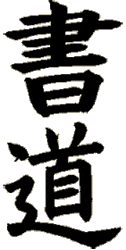One way to learn about Japan is through its traditional calligraphy, which uses a writing brush called a fude (FOO-day) to write beautiful characters on paper. Japanese brush calligraphy is called “shodo,” the Way of Writing, one of the Japanese arts that gets the character for “road” or “way” on the end, like Judo, Aikido, Kendo, and Nintendo (just kidding about that last one). Shodo is taught in Elementary School to encourage appreciation of the art, and it’s common for kids to attend an evening “calligraphy school” to get better and writing with a brush. Even if you don’t read Japanese it can be interesting to learn about how brush calligraphy works — even the lowly kanji for the number ‘1’ (just a horizontal line, e.g. 一) can be fun to learn to write in correct shodo style. Since assembling a writing brush, ink tray and ink can be quite a chore, the Japanese have invented the fude pen, with a flexible brush-like tip that lets you write as if you were using a traditional writing brush. J-List just happens to have these pens freshly restocked, along with books that help you get started, a Magic Calligraphy Practice Sheet that lets you write with water, calligraphy calendars for 2008, wacky Japanese T-shirts featuring calligraphy designs, and more!

Japanese television is always interesting, with a broad mix of entertaining things to watch. You can see variety shows featuring popular “talents” being cute or funny on camera, documentaries about various topics such as ways that rural towns are dealing with declining populations, or travel shows where famous people drive around rural Japan, bathe in hot springs and eat delicious food while viewers watch. The most popular genre of television is the drama, and the TV listings are filled with various shows aimed at different groups of viewers. It’s quite common for dramas to be based on popular manga stories, such as the currently running live-action serialization of Hana-Kimi, the story of a girl who falls in love with a boy she sees at a track-and-field competition; she decides to go to the same high school as him, although since it’s a boy’s school it means she has to disguise herself as a male. Another sub-group of dramas involves Agatha Christie-style murder mysteries in which unlikely female characters must solve murder cases the police can’t crack. One humorous show I caught was called Stewardess Deka, about three JAL flight attendants who flew around the country solving crimes. Anime is also popular, of course, with children’s shows like Sazae-san and Pocket Monster DP at the top of the ratings. Oddly, “prime time” for more involved anime series like the Melancholy of Haruhi Suzumiya is…2 am? Apparently most otaku don’t keep very normal hours.
If you ever need to communicate with Japanese people but don’t know the language, just remember Domo. Domo is an all-purpose Japanese term that essentially means “very” and is found in such phrases as Domo arigatou gozaimasu (thank you very much), Domo sumimasen (excuse me [very much]), and even Domo otsukaresama deshita (thank you for working so hard), said at the end of the day when you leave work. If you can’t memorize these phrases, just remember the word Domo, since Japanese people use this word all the time, leaving the rest of the words unsaid (since they’re picked up from the context anyway) — the Japanese just love to keep their language as vague as possible. So when in a situation where it might be handy to have a Japanese word at hand, just whip out your Domo and you’ll probably be okay. NHK’s popular Domo-kun character, which has become a phenomenon all over the world, essentially exists to teach kids to bow to people they meet and say domo, promoting good manners.
Speaking of Domo, we’re happy to announce a youth size version of our popular “Domo-kun face” T-shirt, a super item for smaller fans of Japan’s cutest spokesmonster. Now your young ones can proudly sport our cool Domo-kun designs, with standard youth size S, M and L in stock. We’ve also lowered the price of all youth size T-shirts as well as our youth-size “tatami sandals” from Japan, which will surely be appreciated by anyone looking for things for today’s Japan-focused kids.
2008 Calendar season has started, and that means soon J-List will be loaded to the gills with gorgeous large-format glossy calendars soon. We’ve posted another volley of fabulous Japanese calendars that are usually only available in the domestic market, including fabulous calendars of traditional Japanese art, Japanese gardens, bonsai, Japanese proverbs written in beautiful calligraphy, and more. Want to see the most beautiful temples in Japan? We’ve got several great calendars. Like bento or sushi? We’ve got calendars for those too. Lovely Yuko Ogura in a kimono? Got it. Oh, our Japanese calendars make great gifts as well!















